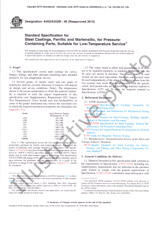We need your consent to use the individual data so that you can see information about your interests, among other things. Click "OK" to give your consent.
ASTM F3582-22
Standard Test Method for Exoskeleton Use: Gaps
Translate name
STANDARD published on 15.11.2022
The information about the standard:
Designation standards: ASTM F3582-22
Publication date standards: 15.11.2022
SKU: NS-1103059
The number of pages: 17
Approximate weight : 51 g (0.11 lbs)
Country: American technical standard
Category: Technical standards ASTM
Annotation of standard text ASTM F3582-22 :
Keywords:
exoskeleton, exosuit, gaps, industrial/occupational, medical, military, recreational, response,
Additional information
| Significance and Use |
|
5.1?Exoskeletons are being used in the industrial/occupational, military, response, medical, and recreational sectors to enhance safety and effectiveness of the user to perform tasks. Traversing gaps is a component of many tasks that someone would do with an exoskeleton. For example, an exoskeleton may be used to help a worker in building construction where gaps in ground surfaces are prevalent. In the military, and other similar environments, soldiers using exoskeletons may traverse gaps along paths carrying loads. Fig. 1 shows examples of gaps typically found in various environments in which persons using exoskeletons may be required to step over gaps. The testing results of exoskeletons shall describe, in a statistically significant way, how reliably the exoskeleton is able to support tasks within the specified types of environments, confinements, and terrains, and thus provide sufficiently high levels of confidence to determine the applicability of the exoskeleton to a given task. 5.2?This test method addresses exoskeleton safety and performance requirements expressed by manufacturing, medical, emergency responders, military, or other organizations requesting this test. The safety and performance data captured within this test method are indicative of the test exoskeletons and the exoskeleton users capabilities. The safety and performance data from these tests are essential to guiding the procurement and deployment decisions of exoskeleton purchasers and users. 5.3?The standard test setup and apparatus (see Section 6) is specified to be easily fabricated. This facilitates evaluation and replication of gap tests by exoskeleton sectors. The standard test setup and apparatus can also be used to support training (see Practice F3444/F3444M) and to establish proficiency of exoskeleton users, as well as provide manufacturers with information about the usefulness of their exoskeleton(s) for tasks. 5.4?Although the test method was developed for the sectors listed in 5.1, it may be applicable to other operational domains. |
| 1. Scope |
|
1.1?Purpose:? 1.1.1?The purpose of this test method, as a part of a suite of exoskeleton use test methods, is to quantitatively evaluate an exoskeletons (see Terminology F3323) performance or safety, or both, of usage by the exoskeleton user (see 1.4) for gaps. 1.1.2?Exoskeletons shall possess a certain set of allowable exoskeleton user movement capabilities, including user-motion adaptability, to suit operations such as: industrial/occupational, military, response, medical, or recreational. Environments in these typical sectors often pose constraints to exoskeleton user movement to various degrees. Being able to step over gaps, as intended by the user or test requestor, while using an exoskeleton is essential for exoskeleton deployment for a variety of tasks. This test method specifies test setup, procedure, and recording to standardize this gaps task for testing exoskeleton user movement. 1.1.3?Exoskeletons need to function as intended, regardless of types of tasks and terrain complexities (for example, carpet, metal, masonry, rock, wood). Required movement capabilities may include, for example: walking, running, crawling, climbing; traversing gaps, stairs, slopes, various types of floor surfaces or terrains, or confined spaces, or combinations thereof. Standard test methods are required to evaluate whether or not exoskeletons meet these requirements. 1.1.4?ASTM Subcommittee F48.03 develops and maintains international standards for task performance and environmental considerations that include but are not limited to, standards for safety, quality, and efficiency. This subcommittee aims to develop standards for any exoskeleton application as exemplified as in 1.1.2. The F48.03 test suite consists of a set of test methods for evaluating exoskeleton capability requirements. This gaps test method is a part of the test suite. The setup, procedure, and apparatuses associated with the test methods challenge specific exoskeleton capabilities in repeatable ways to facilitate comparison of different exoskeleton models or exoskeleton capabilities to tasks. Not all exoskeletons may have the capabilities needed to use this test method. 1.1.5?This test method tests for generic gaps-traversal exoskeleton capability, with straight paths and no test course curves, obstacles, or other complexities not described herein (see 4.6). This test method is considered the basis for exoskeleton gaps capability testing. 1.1.6?The test methods quantify elemental exoskeleton use capabilities necessary for sector applications listed in 1.1.2 and perhaps other applications. As such, users of this standard should use either the entire suite or a subset based on their particular requirements. Users are also allowed to weight particular test methods or particular metrics within a test method differently based on their specific requirements. The testing results should collectively represent an exoskeletons overall safety or performance, or both, as required for the task. These performance data can be used: to guide procurement specifications, for acceptance testing, and for training to use exoskeletons intended for specified applications. Note 1:?Additional test methods within the suite are
anticipated to be developed to address additional exoskeleton
capability requirements, including newly identified requirements
and even for new application domains.
1.2?ExoskeletonThe exoskeleton shall be used as intended by the manufacturer to perform the test described in this test method. If the exoskeleton is not designed for gaps traversing and the test requestor intends to use the exoskeleton to perform a gaps test (for example, for research, development of gaps-capable use by a manufacturer, gaps training as in military applications), appropriate manufacturer approvals should be sought prior to performing the test method. 1.3?Performing LocationThis test method shall be performed in a testing laboratory or at a site that represents the place where the exoskeleton will be used. 1.4?UnitsThe values stated in SI units are to be regarded as the standard. The values given in parentheses are not precise mathematical conversions to inch-pound units. They are close approximate equivalents for the purpose of specifying material dimensions or quantities that are readily available to avoid excessive fabrication costs of test apparatuses while maintaining repeatability and reproducibility of the test method results. These values given in parentheses are provided for information only and are not considered standard. 1.5?This standard does not purport to address all of the safety concerns, if any, associated with its use. It is the responsibility of the user of this standard to establish appropriate safety, health, and environmental practices and determine the applicability of regulatory limitations prior to use. 1.6?This international standard was developed in accordance with internationally recognized principles on standardization established in the Decision on Principles for the Development of International Standards, Guides and Recommendations issued by the World Trade Organization Technical Barriers to Trade (TBT) Committee. |
We recommend:
Technical standards updating
Do you want to make sure you use only the valid technical standards?
We can offer you a solution which will provide you a monthly overview concerning the updating of standards which you use.
Would you like to know more? Look at this page.




 Cookies
Cookies
